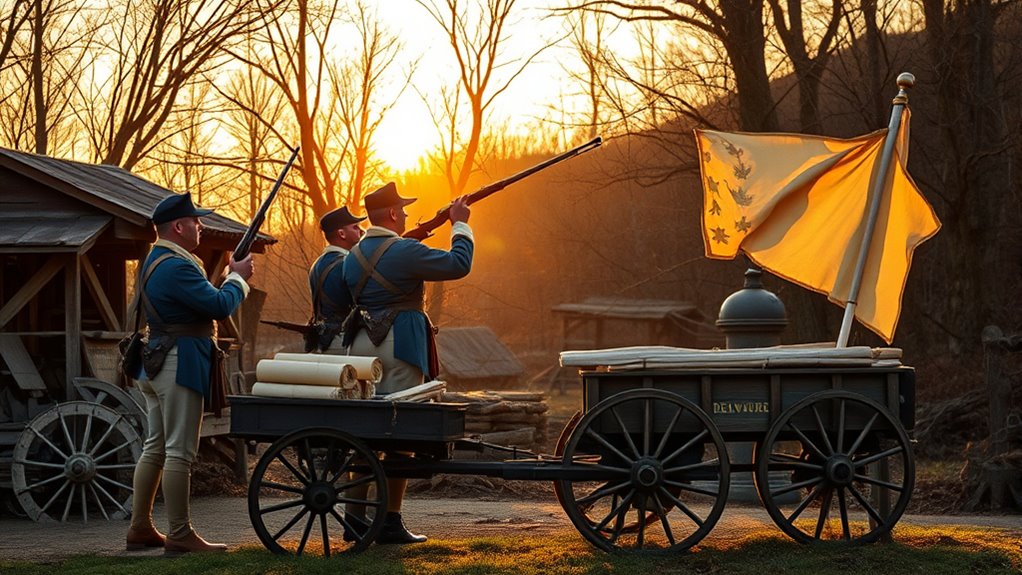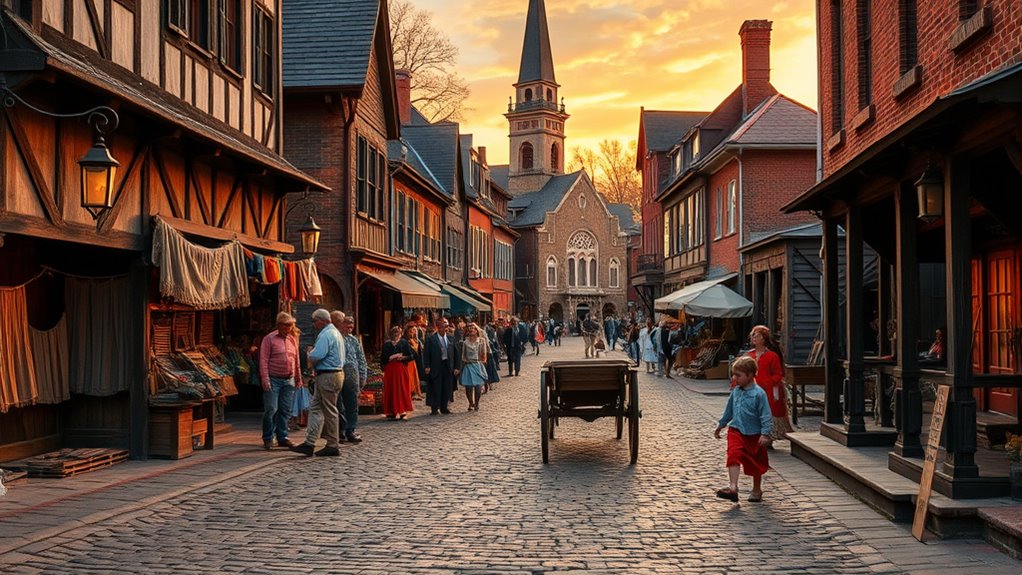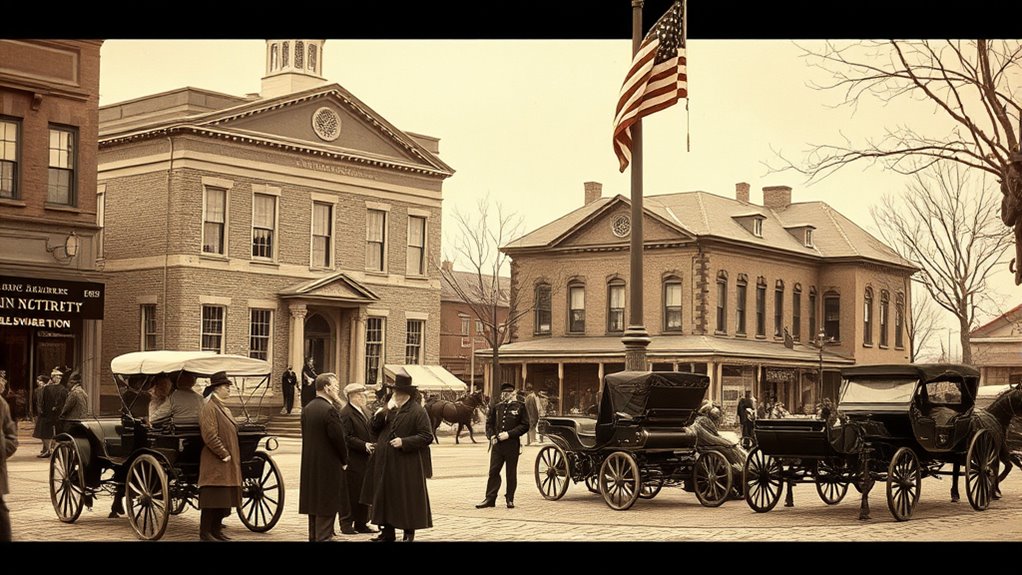Delaware’s history and culture are shaped by Native American tribes, colonial influences from the Dutch, Swedes, and English, and its role in American independence. You’ll see a blend of traditions reflected in architecture, place names, and community celebrations like Powwows and festivals. The state’s strategic location also played a key part in early battles and governance. If you explore further, you’ll uncover how these diverse roots continue to enrich Delaware today.
Key Takeaways
- Delaware’s history is shaped by Native American tribes and European settlers, blending cultures from Swedish, Dutch, and English influences.
- It was the first state to ratify the U.S. Constitution and played a strategic role during the American Revolution.
- Cultural heritage is preserved through historic sites, museums, festivals, and community events celebrating Native American, colonial, and African American traditions.
- Delaware’s governance evolved from colonial roots to modern reforms, emphasizing civic participation and political stability.
- Its strategic location along waterways has influenced military history and fostered diverse cultural festivals and celebrations.
Early Native Inhabitants and Colonial Beginnings

Have you ever wondered who first called Delaware home? Long before Europeans arrived, Native American tribes like the Lenni Lenape, Susquehanna, and Nanticoke inhabited the land. These peoples thrived here, establishing rich cultures and trading networks. In 1627, the Swedes established the first European settlement near Fort Christina, now Wilmington, creating New Sweden. The Dutch followed, building forts at Zwaanendael (Lewes) in 1631 and near Newcastle in 1651. By 1655, the Dutch lost control to the Dutch, and in 1664, the British took over. During this early period, colonial powers claimed much of the land, while Native tribes maintained their presence and cultures. The early European settlements laid the groundwork for Delaware’s diverse history, blending Native roots with European influence.
Colonial Governance and the Formation of a Distinct Identity

As colonial powers vied for control, Delaware began to develop a distinct political identity by establishing its own legislative institutions. In 1703, it separated from Pennsylvania but initially shared a governor, maintaining a unique local government. The first Delaware General Assembly convened in 1704 in New Castle, marking the start of its independent legislative tradition. In 1701, Delaware was officially separated from Pennsylvania, solidifying its political independence. During this period, Delaware’s government reflected a blend of influences from Swedish, Dutch, and English settlers, shaping local laws and institutions. Its governance evolved through conflicts and compromises, fostering a sense of autonomy. This foundation laid the groundwork for its later role in American independence and helped forge a distinct identity within the broader colonial landscape. The development of local institutions played a crucial role in shaping Delaware’s unique political and cultural identity.
The Revolutionary War and Delaware’s Path to Statehood

During the American Revolution, Delaware played a crucial role in shaping the nation’s fight for independence. You might be surprised to learn that Delaware was the first state to ratify the U.S. Constitution on December 7, 1787, earning it the nickname “The First State.” On June 15, 1776, Delaware’s Assembly declared independence from Britain and Pennsylvania, signaling its commitment to liberty. Delaware also fought in the Revolution, with the Battle of Cooch’s Bridge on August 30, 1777, marking the only major Revolutionary War battle in the state. Despite internal Loyalist resistance, Delaware’s residents supported independence, and their efforts helped pave the way for statehood. This period established Delaware’s identity as an early supporter of American freedom and self-governance. The period also involved significant military engagement, which further solidified its role in the fight for independence.
Social and Cultural Development Through the Colonial Era

The social and cultural landscape of Delaware took shape through the diverse influences of its colonial settlers and Native American tribes. As you explore, you’ll see how Native nations like the Lenni Lenape, Susquehanna, and Nanticoke contributed traditions, stories, and trading practices that shaped early community life. European settlers—Swedes, Dutch, and English—brought their customs, religions, and governance structures, blending with Native influences. You’ll notice how settlements like New Sweden and Dutch forts fostered cultural exchange and economic growth. Delaware’s early society reflected a mix of influences, with settlers establishing local laws, churches, and schools that incorporated diverse traditions. These interactions created a vibrant, evolving culture rooted in cooperation, conflict, and adaptation during the colonial era. Additionally, the integration of different cultural influences played a key role in shaping the region’s unique social fabric.
Civil War Era and the Shift Toward Modern Governance

Despite its early history of balancing diverse colonial claims, Delaware faced significant social and political shifts in the Civil War era. As a Union state, Delaware maintained its loyalty despite being a slave state before the war’s end. The abolition of slavery in 1865 marked a pivotal transition, reflecting changing social attitudes and the move toward modern governance. The Delaware General Assembly adapted with reforms, culminating in the 1897 state constitution, which still guides governance today. You can see how Delaware’s political landscape became more accessible and citizen-focused, with a bicameral legislature and an independent judiciary. These changes helped modernize the state’s government, balancing tradition with progress, and set the stage for Delaware’s continued role in national affairs.
Key Economic Milestones and Symbols of State Pride

Economic growth in Delaware has been shaped by key milestones that reflect its innovative spirit and strategic location. The founding of the DuPont Company in 1802 marked a major industrial milestone, transforming Delaware into a hub for chemical manufacturing and innovation. The state’s symbols, including the Delaware flag with its colonial blue and buff colors and the state seal featuring a shield with agricultural and maritime elements, embody pride and history. Delaware’s nickname, “The First State,” highlights its pivotal role in American independence, ratifying the U.S. Constitution first in 1787. These symbols and milestones showcase Delaware’s resilience, forward-thinking, and foundational place in American history. They serve as enduring symbols of pride, connecting residents and visitors to the state’s rich economic and cultural legacy. Additionally, Delaware’s focus on leadership skills and strategic development has fostered a business-friendly environment that continues to attract innovation and growth.
Delaware’s Role in American Independence and Strategic Significance

As the first state to ratify the U.S. Constitution, Delaware played a crucial role in establishing American independence. Its strategic location along key colonial trade routes made it vital during the Revolutionary War and early nation-building. You can see how Delaware’s early assertiveness and geographic position helped shape the nation’s foundation.
First State’s Independence
Have you ever wondered why Delaware is called “The First State”? It’s because Delaware was the first to ratify the U.S. Constitution on December 7, 1787, making it the very first to join the Union. Before that, it declared independence from Britain on June 15, 1776, and adopted its own constitution on September 11 of the same year. During the Revolutionary War, Delaware’s troops earned a reputation for bravery, notably at the Battle of Cooch’s Bridge. Its strategic location along the Delaware River made it essential for trade and defense. By asserting its independence early, Delaware helped set the stage for the new nation, earning its nickname and cementing its role in American history. Additionally, Delaware’s role in American independence highlights its importance in the formation of the United States.
Strategic Colonial Position
Delaware’s strategic location along the Delaware River positioned it as a key player in the early struggles for American independence. Its proximity to Philadelphia made it essential for trade, troop movements, and communication between colonies. During the Revolutionary War, Delaware’s geographic position allowed it to control access to critical waterways and serve as a buffer zone between the British and Patriot forces. The Battle of Cooch’s Bridge in 1777 marked its military significance. Moving its capital to Dover in 1777 enhanced its defensive posture. Delaware’s location also facilitated alliances with neighboring states and influenced political decisions. Its role as “The First State” reflects its early involvement in independence efforts, with its strategic position shaping both military and political outcomes during the fight for liberty. Additionally, its strategic colonial position contributed significantly to its influence in early American history.
Influences of Diverse Colonial Powers on Delaware’s Heritage

The rich heritage of Delaware reflects the powerful influences of multiple colonial powers that shaped its development. You can see Dutch, Swedish, and British legacies in the architecture, place names, and legal traditions that still exist today. The Swedes introduced early settlement techniques and established New Sweden, leaving a lasting cultural imprint. The Dutch built forts and expanded trade networks, influencing commerce and governance. When Britain took control in 1664, it brought English laws, language, and political structures that integrated with local Native American customs. These diverse colonial powers created a melting pot of traditions, blending European and Native influences. Additionally, the incorporation of creative practices in various cultural expressions illustrates how Delaware’s heritage continues to evolve through innovative adaptation. As a result, Delaware’s heritage is uniquely layered, reflecting a complex history of conquest, settlement, and cultural exchange that continues to shape its identity.
Contemporary Cultural Identity and Preservation Efforts

You can see Delaware’s vibrant cultural identity through its various heritage preservation initiatives and lively festivals that celebrate its diverse history. These efforts help keep traditions alive while engaging communities and visitors alike. By participating in or supporting these events, you contribute to maintaining the state’s rich cultural legacy for future generations. Recognizing the importance of cultural preservation plays a crucial role in sustaining Delaware’s unique identity.
Heritage Preservation Initiatives
Heritage preservation initiatives in Delaware play a vital role in maintaining the state’s rich historical and cultural identity. You can explore efforts like restoring historic sites, supporting local museums, and promoting educational programs that highlight Delaware’s unique past. These initiatives involve partnerships between government agencies, nonprofits, and communities dedicated to safeguarding landmarks such as Fort Christina and the Zwaanendael Site. By actively participating or visiting these sites, you help keep Delaware’s history alive. Here’s a quick look at some key preservation efforts:
| Initiative | Focus Area | Impact |
|---|---|---|
| Historic Site Restoration | Colonial and Native sites | Preserves architecture, educates visitors |
| Museum Funding | Local history collections | Ensures access to artifacts and stories |
| Educational Programs | Schools and communities | Raises awareness about heritage |
| Landmark Designation | Recognizing historic buildings | Protects structures from demolition |
| Community Involvement | Volunteer and advocacy efforts | Engages residents in preservation |
Additionally, understanding the history of dog breeds can deepen appreciation for cultural diversity and heritage.
Cultural Festivals and Events
Cultural festivals and events in Delaware serve as vibrant expressions of the state’s diverse history and contemporary identity. You’ll find celebrations that honor Native American heritage, such as Powwows and storytelling festivals, preserving indigenous traditions. Throughout the year, community events like the Dover International Speedway races and Wilmington’s African American Festival showcase local pride and cultural diversity. Historic reenactments, like Revolutionary War battles, bring history to life, while food festivals highlight Delaware’s culinary roots, including seafood and farm-to-table cuisines. These events foster community, celebrate shared heritage, and help preserve traditions for future generations. By participating in these festivals, you connect with Delaware’s rich past and vibrant present, strengthening the state’s cultural fabric and ensuring its history remains alive and relevant today.
Frequently Asked Questions
How Did Native American Tribes Influence Delaware’s Early Development?
Native American tribes deeply influenced Delaware’s early development by shaping the land, culture, and social structures. You can see their impact in local traditions, trade networks, and interactions with European settlers. Their knowledge of the environment helped early communities survive and thrive. Native tribes also contributed to Delaware’s diverse heritage, influencing its laws, customs, and settlement patterns, leaving a lasting mark on the state’s identity.
What Role Did Delaware Play in the American Revolution Beyond Independence?
You might think Delaware was just a quiet background in the Revolution, but it played a vital role. Delaware’s troops, known as “Blue Hen’s Chickens,” fought bravely at the Battle of Long Island, boosting morale. The state’s strategic location made it essential for supply routes and communication. Additionally, Delaware’s early declaration of independence and its first constitution helped shape the nation’s founding principles.
How Has Delaware’s Colonial History Shaped Its Modern Legal System?
Your modern legal system in Delaware is shaped by its colonial history, especially its early governance and legislative roots. You benefit from a bicameral legislature established in 1704 and a constitution adopted in 1897. The influence of diverse colonial powers, including Swedish, Dutch, and English, fostered a legal tradition emphasizing citizen participation and accessible laws. This foundation makes Delaware’s legal system unique and adaptable, reflecting its rich colonial past.
In What Ways Do Delaware’s Symbols Reflect Its Historical Significance?
You’ll notice Delaware’s symbols vividly reflect its historical significance. The state flag features a shield from the colonial era, symbolizing its early settlement roots. The seal includes agricultural symbols, highlighting its farming history, while “The First State” nickname honors its role in American independence. These symbols celebrate Delaware’s unique identity, its colonial past, and its essential place in shaping the nation’s history.
How Are Delaware’s Diverse Colonial Influences Preserved Today?
You can see Delaware’s diverse colonial influences woven into your daily life, like a tapestry rich with history. From Swedish-inspired architecture to Dutch place names, these traces are preserved in local traditions, museums, and historic sites. You’re living among the echoes of Native American tribes and early settlers, keeping their stories alive through festivals, landmarks, and education. Delaware’s history isn’t just in books—it’s part of your everyday landscape.
Conclusion
You might think history is just dates and events, but Delaware’s rich heritage shows how diverse influences shape identity. By understanding its Native roots, colonial struggles, and role in independence, you see a vibrant story of resilience. Don’t overlook the importance of preserving this history—you’re part of its ongoing legacy. Embracing Delaware’s culture helps you appreciate how past struggles and triumphs continue to influence who we are today.








